One of the most common instructions in tennis is: “Brush up on the ball to create topspin.”
At first glance, this advice seems logical. If a player is hitting too flat, we naturally want them to lift the ball and add spin for safety and control.
So we tell them: “Brush up more!”
But that simple phrase causes more harm than good.
In this article, I’ll explain why this instruction is problematic, what kind of technical flaws it creates, and—most importantly—how players actually generate topspin in a way that leads to powerful, penetrating shots.
The Problem With “Brush Up on the Ball”
When tennis players hear this instruction, they tend to take it literally.
They understand it as a steep motion on the back of the ball. So what do they do?
They drop the racket under the ball and then brush it up in a sharp and upward line.

While the coach's intention to teach topspin is well meaning, most adult players MISINTERPRET what "brushing up" means.
This results in a steep racket path and a stiff and locked wrist; then the contact gets suddenly weak and often the ball doesn’t even make it over the net.
In fact, even though this motion produces a topspin, it’s actually disconnected from the energy of the swing.
So that leads to no penetration, no weight, and no flow. You might generate a decent spin, but the shot will have no power, and it will often land short.
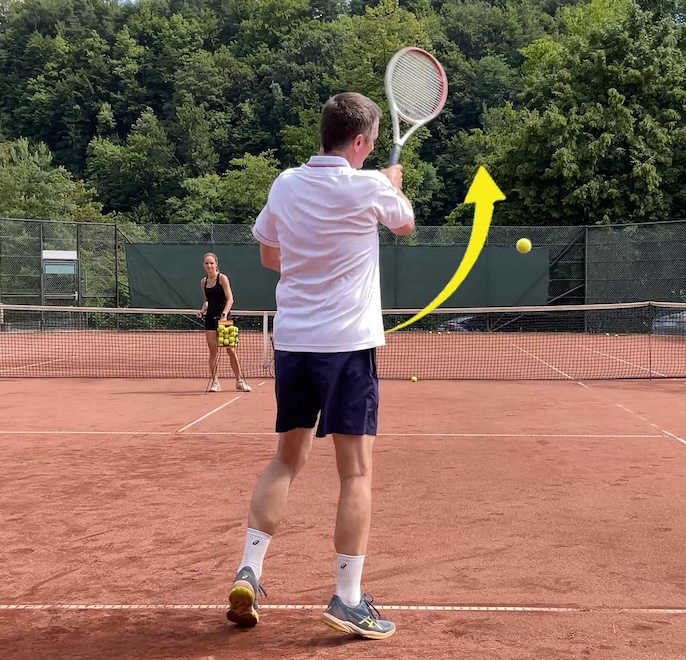
Such a steep swing path with a stiff wrist produces short balls.
So, you might wonder what actually works?
“Slap and Spin” is the answer!
The actual topspin in tennis is not just a brushing motion; simply said, it’s a slap on an upward path.
Many professional players have a fluid swing and clean contact, and the balls jump off the strings with both speed and spin.
But they don't get his from brushing steeply forward.
This comes from hitting through the ball while moving the racket on a slightly upward swing path.
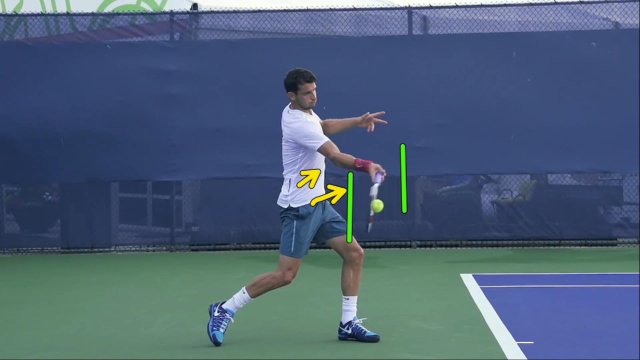
Dimitrov's racket remained perpendicular through contact with a shallow swing path upwards.
Before you can add an effective topspin, you must learn to hit the ball cleanly and effortlessly.
To be able to do that, you need to feel the lag of the wrist and racket, and then you need to let the racket swing freely like a pendulum.
Then you can make a clean and flat contact with relaxed hands and minimal effort.
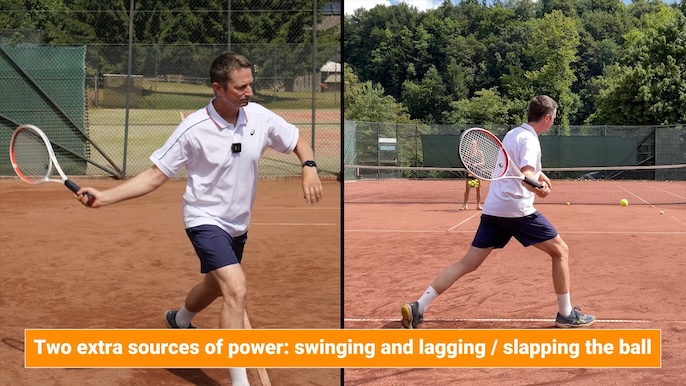
The foundation of every groundstroke needs to be a flat, clean stroke based on swinging and "slapping" the ball.
Remember that from forcing the shot or brushing upward, you don’t get real power.
To perfect your game, you can practice by hitting the ball without moving your legs or shoulders and with no full swings.
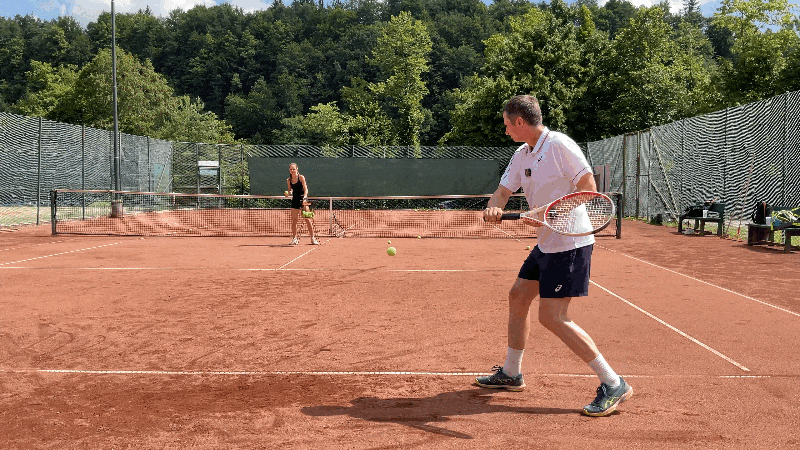
Can you see the "slap" in action in this one-handed backhand example?
You would be just standing and slapping the ball with your hands, and you’ll be amazed how far the ball can go when the contact is clean.
Once this foundation is in place, then you can use the topspin on top of it without destroying the power.
Watch the above video for the demonstration of clean hitting with very low level of spin.
How We Actually Hit Topspin In Tennis
So the way we hit a groundstroke in tennis that have some spin and yet retains good speed and depth, is that we combine a swinging and slapping the ball with an upwards swing path.
But do note in the image below that my swing path is way more shallow than what "brushing up" concept would have you believe.
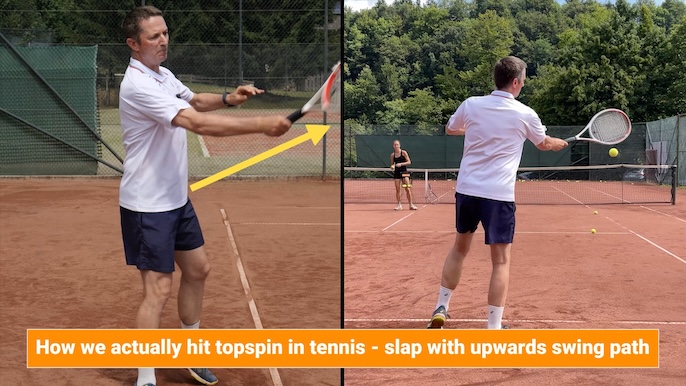
While I do have an upward path on the ball, it is not really steep.
The majority of your energy and swing path towards the ball has to have more of a horizontal component which includes the "slap" movement and only a small part of the movement has to have a vertical component when we are hitting from the baseline.
How To Develop Topspin The Right Way
So what can we do to give the player a good feel of the topspin and not use the "brushing up" concept?
I propose the "Press & Roll" drill which I extensively covered in the first video article published on FeelTennis.net.
Here's a shorter version with a few variations:
Drill 1: Press and roll between 2 rackets (forehand only)
Hold a tennis ball between two rackets and press them together.
Use the racket in your non-dominant hand as the "wall" against which you press & roll the ball with the racket in your dominant arm.

While you can do this only on the forehand side, it will create good mental model for the backhand strokes.
After a few "rolls" up and down, pull the racket over the top of the non-dominant arm's racket.
Perform the drill 10-15 times. Then, drop-feed the ball to yourself and hit 10-15 shots.
On each shot, focus on a quick "press and roll," and visualize a high, looping trajectory over the net.

Eventually you need to hit the ball at real speed so do not exaggerate the rolling motion any more, it needs to flow.
Drill 2: Partner press and roll
For this drill your coach or partner holds their racket out in front of you.
Place a ball against the strings of their racket, and with your racket you will press and roll the ball up and over the strings.

Showing a topspin press & roll drill one-handed backhand example with a partner.
Repeat the drill 10-15 times. Then, have your partner drop-feed the ball to you.
Hit each shot with a more fluid motion, quickly visualizing the press and roll principle as you make contact.

You now need to transition from the exaggerated press & roll drill into a quick, fluid motion.
These drills help reinforce the ideal contact point out in front and promote a more fluid, smooth swing.
This directly counters the common mistake of "brushing up," which causes a short swing and a stiff wrist, preventing you from generating real power.
Do We Need Topspin To Control The Ball?
You actually don’t need extreme spin to control the ball; you need to learn how to hit with the right trajectory, control your pace, and use depth and arc to your advantage.
Once you're comfortable with that, you can start adding spin through a natural swing path and progressive drills, not by forcing it.
Another way - shown in the video here - is to use implicit ways of learning topspin using various constraints that naturally encourage your technique to apply topspin without over-thinking technical details.
So before chasing the spin, master the fundamentals of contact and swing.
Build your power with the provided drills, then layer in spin with the right mechanics, and you will feel more confident and stable in your baseline rallies.

